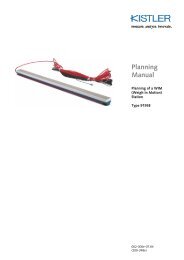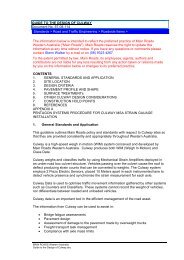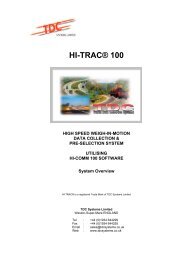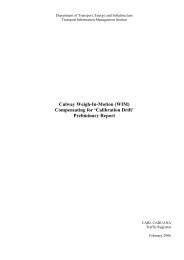AP-G84/04 Best practice in road use data collection, analysis ... - WIM
AP-G84/04 Best practice in road use data collection, analysis ... - WIM
AP-G84/04 Best practice in road use data collection, analysis ... - WIM
Create successful ePaper yourself
Turn your PDF publications into a flip-book with our unique Google optimized e-Paper software.
Accessed by AR - ARRB TRANSPORT RESEARCH on <strong>04</strong> Feb 2005<br />
Aust<strong>road</strong>s 20<strong>04</strong><br />
— 25 —<br />
<strong>Best</strong> Practices <strong>in</strong> Road Use Data Collection, Analysis and Report<strong>in</strong>g<br />
Frequency of Sampl<strong>in</strong>g<br />
The issue of frequency of traffic counts relates <strong>in</strong> particular to the frequency at which short-term<br />
counts are conducted at specific sites. In determ<strong>in</strong><strong>in</strong>g the frequency of <strong>data</strong> <strong>collection</strong>, a <strong>road</strong><br />
authority will need to consider the rate of change of values of particular <strong>data</strong> types. The accuracy,<br />
quality and currency of the <strong>data</strong> should be determ<strong>in</strong>ed with reference to the cost of collect<strong>in</strong>g those<br />
<strong>data</strong> and the value and benefit of that <strong>data</strong> (Western European Road Directorate 2003). The issues<br />
are summarised as follows:<br />
With<strong>in</strong> a year – number of sampl<strong>in</strong>g periods, e.g. once, twice or more times per year;<br />
duration of each sampl<strong>in</strong>g period, e.g. 1 h, 1 day, 1 week or more; when to survey, e.g.<br />
randomly, outside school holidays or at each season; consistency with previous surveys;<br />
Between years – predictability and consistency of traffic growth; predictability and<br />
consistency of factors lead<strong>in</strong>g to traffic growth; existence or otherwise of commodity <strong>in</strong> traffic<br />
flows between areas or <strong>road</strong> types, e.g. rural versus urban or National Highways versus ma<strong>in</strong><br />
<strong>road</strong>s;<br />
External demands – <strong>in</strong>ternal <strong>road</strong> authority requirement; external government agency<br />
requirements; political or public relations demands.<br />
The frequency of collect<strong>in</strong>g short-term traffic counts varies amongst RAs. The current <strong>practice</strong>s<br />
range from a frequency of a sample once every year to as <strong>in</strong>frequent as ten years apart. Most RAs<br />
sample at a frequency of once every two to three years. With<strong>in</strong> this sample program, one half or<br />
one third of the sites are sampled <strong>in</strong> any year, result<strong>in</strong>g <strong>in</strong> all sites covered over a two to three year<br />
cycle (described as a ‘roll<strong>in</strong>g’ program). Increas<strong>in</strong>g budgetary pressures are lead<strong>in</strong>g RAs to lower<br />
<strong>collection</strong> frequencies, e.g. from three to four years to five to six years <strong>in</strong> South Australia.<br />
Further ‘f<strong>in</strong>e-tun<strong>in</strong>g’ is applied with<strong>in</strong> a sampl<strong>in</strong>g frequency regime, by differentiat<strong>in</strong>g between<br />
classes of <strong>road</strong> (urban and rural) as well as with<strong>in</strong> classes of <strong>road</strong> (ma<strong>in</strong>ly rural). Thus, Western<br />
Australia reported a two year metropolitan cycle and a five year rural cycle while Tasmania<br />
reported sampl<strong>in</strong>g 100 sites every two years, 300 sites every five years and 450 sites every ten<br />
years.<br />
It is good <strong>practice</strong> that the sampl<strong>in</strong>g <strong>in</strong>terval should not extend beyond three years, under what can<br />
generally be described as ‘normal’ conditions. In <strong>practice</strong>, sampl<strong>in</strong>g frequency is a balance of<br />
costs and accuracy, and recognition of chang<strong>in</strong>g traffic conditions, best determ<strong>in</strong>ed by the <strong>use</strong>rs of<br />
the <strong>data</strong> themselves. As such, for rural <strong>road</strong>s where traffic counts hardly change, a ten year<br />
sampl<strong>in</strong>g frequency may be justifiable, as with some <strong>road</strong>s <strong>in</strong> Tasmania. This, of course, would not<br />
apply to rural <strong>road</strong>s closer to urban areas, where it is likely that conditions will change more rapidly.<br />
The local knowledge of RAs enables f<strong>in</strong>e tun<strong>in</strong>g with<strong>in</strong> portfolios of count stations, to achieve cost<br />
effectiveness <strong>in</strong> the count<strong>in</strong>g program.<br />
4.3.2 Def<strong>in</strong><strong>in</strong>g a Homogeneous Section<br />
Homogeneous sections are utilised to transpose AADTs calculated for specific survey locations, as<br />
part of the sample traffic count<strong>in</strong>g program, across to <strong>road</strong> sections <strong>in</strong> the total <strong>road</strong> network. By<br />
assign<strong>in</strong>g an AADT for each <strong>road</strong> section <strong>in</strong> the network, a calculation for VKT can be made,<br />
multiply<strong>in</strong>g the <strong>road</strong> section length by the AADT and add<strong>in</strong>g up across all <strong>road</strong> sections.<br />
Homogeneous sections are groups of <strong>road</strong>s or ‘strata’ or ‘uniform traffic segments’ (UTS), each of<br />
which <strong>in</strong>cludes a relatively large number of segments that can be regarded as a ‘population’ for<br />
statistical sampl<strong>in</strong>g. Homogeneous sections also relate to groups of <strong>road</strong>s to which adjustment<br />
factors, described earlier, can be applied. FHWA (2001) describes the creation of ‘factor groups’<br />
(similar to homogeneous sections) as follows:

















